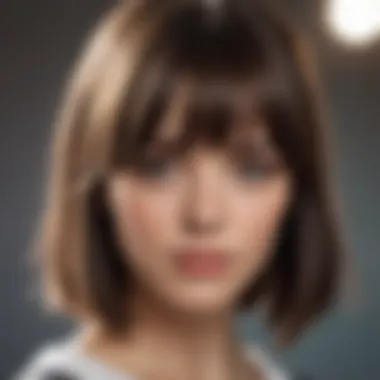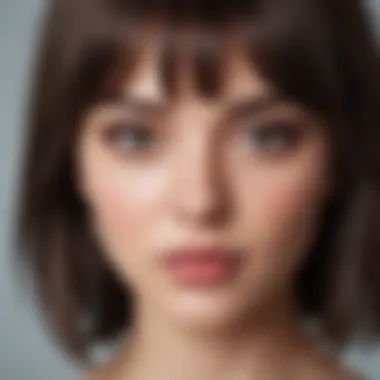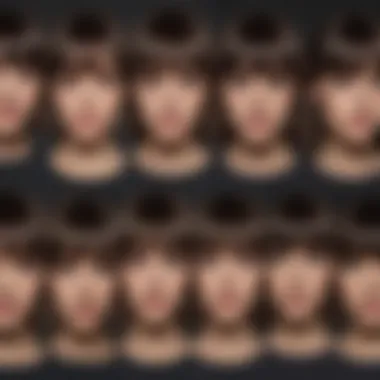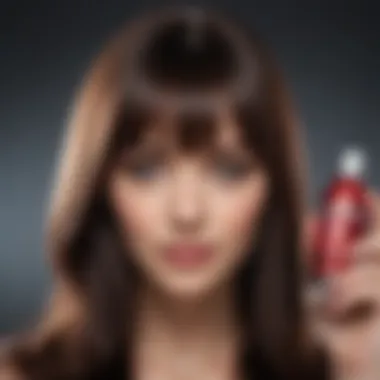Crafting Bangs for Thin Hair: Techniques & Tips


Intro
Creating bangs for thin hair presents unique challenges and opportunities. Thin hair, often lacking volume, demands specific styling techniques to achieve a flattering outcome. This article will delve into the various aspects of crafting bangs tailored to thin hair, from understanding different face shapes to exploring suitable styles and maintenance tips. It is critical to make informed choices that enhance one’s personal look while also preserving hair health. For those seeking to elevate their hairstyles, this guidance will serve as a valuable resource.
Trending Topics
Current Fashion Trends
In the world of hair fashion, bangs remain a staple. Recently, styles have shifted toward softer, more blended looks that seamlessly integrate with the rest of the hair. Wispy bangs have gained popularity, offering a gentle frame that adds texture without overwhelming thin hair. Moreover, curtain bangs can enhance volume and are adaptable across various face shapes, making them a versatile choice.
Beauty Innovations
The latest beauty innovations focus on enhancing thin hair rather than disguising it. Products such as volumizing powders and thickening sprays are designed specifically for fine hair. Additionally, tools like difusers and crimpers can create volume and texture, allowing bangs to look fuller and more natural. Staying updated with these innovations can ensure a contemporary look that resonates with current aesthetics.
Step-by-Step Guides
Fashion Styling Tips
- Choose the Right Bang Style: Select a bang style that complements your face shape. For example, round faces may benefit from longer side-swept bangs, while square faces can pair well with softer, rounded bangs.
- Consult a Professional: When in doubt, seek the advice of a hairstylist experienced with thin hair. They can offer personalized guidance based on your unique hair type and desired look.
- Aim for Subtle Layers: Layering can create the illusion of thickness. Subtle layers around the bangs can add dimension and movement without sacrificing volume.
Beauty Routines
To maintain healthy bangs in thin hair, consider adopting the following routines:
- Regular Trims: Keeping bangs trimmed prevents split ends and maintains their shape.
- Gentle Shampoo and Conditioner: Use products formulated for fine hair to avoid weighing it down.
- Heat Protection: Always apply a heat protectant before using styling tools to mitigate damage.
Product Reviews
In-Depth Analysis of Popular Items
- Oribe Maximista Thickening Spray: Known for its lightweight formula, this spray adds a notable lift without heaviness, ideal for enhancing thin bangs.
- Bumble and Bumble Thickening Hairspray: This product boasts a unique texture that delivers volume while offering support and flexibility for styling.
Comparative Reviews
When selecting products, compare based on performance, ingredients, and reviews. Tools like Beautypedia can provide insights into the effectiveness and formulation of various styling products.
"Choosing the right products and techniques can dramatically change the appearance of thin hair and help you achieve the bangs of your dreams."
The End
Creating the perfect bangs for thin hair encompasses understanding current trends, employing the right techniques, and selecting suitable products. By keeping these elements in mind, you can achieve a stylish look that enhances your features while maintaining the health of your hair. Experimentation is key, so embrace the process and enjoy the transformation.
Understanding Thin Hair
Developing an understanding of thin hair is a crucial foundational step when considering bangs. Thin hair, while often beautiful, presents unique challenges that differ significantly from thicker strands. When crafting bangs, it is imperative to consider their behavior, volume, and how they interact with the overall hairstyle. This section will explore the essential characteristics of thin hair and the common difficulties encountered, addressing key elements that can influence effective styling techniques.
Characteristics of Thin Hair
Thin hair typically possesses a lower density and diameter compared to thicker hair types. This can lead to various visual and tactile aspects:
- Lack of Volume: Thin hair may appear flat and lifeless if not styled with care. This is a primary consideration when selecting bangs that enhance fullness.
- Delicate Texture: The strands are often finer and may be more prone to damage. This requires the use of gentle styling products that do not weigh the hair down.
- Natural Shine: Thin hair can showcase a healthy shine when properly cared for. This quality can be highlighted with the right shampoo and conditioner.
- Scalp Visibility: Due to lower density, the scalp may be more visible, which influences choices in hairstyles and cuts, especially for bangs.
Understanding these characteristics allows for the selection of bangs that can create the illusion of fullness, play with texture, or draw attention away from less volumized areas.
Common Challenges with Thin Hair
While styling thin hair can be rewarding, it also presents specific challenges that must be navigated carefully:


- Easily Over-Processed: Thin hair can become damaged quickly from excessive heat or harsh chemical treatments. Maintaining health is paramount.
- Difficulties in Styling: Achieving lasting results can be challenging. Thin hair may not hold its shape as well as thicker types, occasionally leading to a look that falls flat or becomes unmanageable throughout the day.
- Frizz and Static: Due to their lightweight nature, thin hair can be more susceptible to frizz and static, especially in humid conditions, complicating the styling process.
- Limited Style Options: Certain styles may not be suitable for thin hair, requiring careful consideration of what cuts work best.
These aspects highlight the importance of tailored approaches when styling bangs, ensuring that the chosen technique complements the hair's inherent qualities rather than fighting against them.
"Understanding the nature of your hair is the first step towards successful styling."
When one acknowledges these characteristics and challenges, selecting and maintaining bangs for thin hair becomes an informed and strategic process.
Bangs: An Overview
Bangs can serve as a transformative element in a hairstyle, particularly for those with thin hair. Their ability to frame the face and create a fresh aesthetic makes bangs an appealing option. However, the significance of this section lies in understanding the nuances associated with bangs, especially for individuals with finer hair textures.
In this context, bangs are not merely a fashion statement; they need to be approached with specific considerations related to hair density and styling techniques. A well-crafted bang can add volume and style without overwhelming thin hair. For women looking to enhance their overall appearance, understanding the details of various bang styles and their corresponding benefits is crucial.
Defining Bangs
Bangs are sections of hair that are cut straight across the forehead. They can vary greatly in length, thickness, and shape, which allows for a wide array of styles. Bangs can be blunt, wispy, or side-swept and can significantly impact an individual's facial profile.
For those with thin hair, not all types of bangs are suitable. Blunt bangs may appear too heavy, while wispy bangs can help create an illusion of fullness. It is essential to choose a style that complements one’s hair texture and face shape, ensuring a harmonious look.
Bangs can be styled in numerous ways, enhancing versatility. Women can choose bangs that suit their lifestyle and personal grooming habits. The right bangs can boost confidence and allow for creative expression through hair.
Historical Context of Bangs
The history of bangs is rich and varied, tracing back to ancient civilizations. Bangs have been worn since the time of the Egyptians, where both men and women sported short fringes that often denoted status. Through different eras, from the bobbed hairstyles of the 1920s to the layered cuts of the 1980s, bangs have evolved and adapted.
In the modern era, bangs have experienced a resurgence in popularity, thanks in part to influencers and celebrities who embrace this style. Iconic figures like Audrey Hepburn and more recently, celebrities like Rihanna, have highlighted how bangs can be a focal point in a hairstyle.
This historical perspective shows that bangs are enduring and possess a certain timelessness. They reflect cultural shifts and personal choices. Understanding this context can provide valuable insights for those considering bangs as a hairstyle option today.
Choosing the Right Bangs for Thin Hair
Choosing the right bangs for thin hair is crucial for achieving a flattering and well-balanced look. Thin hair often presents specific challenges, such as lack of volume and body. Therefore, it is essential to consider several elements when selecting bangs. The ideal style can provide fullness and frame the face effectively. Understanding face shapes and hair density can guide choices, ensuring the bangs enhance overall appearance rather than detract from it.
To make an informed decision, examining the interplay between face shape and bangs is key. Different styles complement varying facial structures. Bangs can draw attention to your best features, create the illusion of thickness, and contribute to a cohesive hairstyle. Overall, the right bangs can serve as a transformative element for women with thin hair.
Face Shapes and Bang Styles
Round Face
A round face is characterized by soft angles and equal width and height. For women with this face shape, bangs can add definition and elongate facial features. The gentle curves of a round face allow for bangs that are either soft and wispy or blunt and straight.
The benefits of bangs for a round face include increased balance. By opting for layered or side-swept bangs, a round face can appear more oval. However, overly blunt bangs can emphasize roundness. Thus, a thoughtful styling approach is needed.
Square Face
The square face shape features strong jawlines and wider foreheads. This structure allows for bangs that soften the overall look. Bangs can frame the forehead and create a gentle contrast with the jawline.
A popular choice for square faces is textured, side-swept bangs. These add movement and prevent the face from appearing too angular. Nonetheless, straight, blunt bangs may enhance the square look. A careful selection of styles is important for this face shape.
Oval Face
Oval faces are considered versatile, as they are longer than they are wide. Many bang styles suit this shape, making selection flexible. Soft, curved bangs or blunt bangs work well, often flattering the entire face.
This flexibility can be beneficial. Bangs may be adjusted in length, allowing creativity. However, wearing excessively long bangs can overwhelm the face; therefore, maintaining balance is vital.
Heart-Shaped Face


Heart-shaped faces typically feature a wider forehead and narrower chin. Bangs can help balance these proportions, drawing attention away from the forehead towards the cheekbones.
Wispy or side-swept bangs are often beneficial for this shape. They add softness and can create an appealing look. Disadvantages include the potential for bangs to highlight the forehead if not styled correctly. It’s essential to keep in mind the unique characteristics of a heart-shaped face.
Hair Density Considerations
When selecting bangs for thin hair, density plays a significant role. Thin hair necessitates specific styling techniques to avoid an overly flat appearance. Layers can introduce movement and volume, enhancing the overall look. Similarly, bangs should not be overly thick, as this can weigh thin hair down. Instead, light, textured bangs work well, as they create depth without excessive bulk.
Styling Techniques for Bangs on Thin Hair
When it comes to styling bangs for thin hair, the techniques used can significantly impact the overall look and feel. Understanding the right approach is crucial for ensuring that bangs not only flatter yet also enhance the delicate nature of thin hair. The right styling techniques can create the illusion of volume, provide shape, and maintain health in thin strands. This section explores cutting methods and blow-drying practices that cater specifically to thin hair, ensuring that the end result complements the individual's features.
Cutting Techniques
Point-Cutting
Point-cutting is a cutting technique employed to create texture in the hair. This method involves snipping the ends of the hair at various angles, instead of straight across. This approach helps to soften the bluntness of a standard cut, allowing for a more blended appearance. For thin hair, point-cutting can be particularly advantageous because it does not take away significant length but enhances the overall shape. The most notable characteristic of point-cutting is its ability to add dimension without losing volume.
The key benefit of point-cutting is its versatility; it can be applied to various styles of bangs, whether blunt or wispy. However, too much point-cutting on thin hair can lead to fraying, so the technique must be executed with care. It is generally best for women wanting a softer look that appears effortlessly styled, making it a popular choice in this article.
Texturizing
Texturizing involves removing bulk from the hair using thinning shears or razors. This method is about balancing thickness and achieving an airy feel. For thin hair, texturizing can provide movement and prevent the bangs from appearing flat or lifeless. The unique feature of texturizing is its ability to create layers that add depth while maintaining a manageable length.
One key characteristic of texturizing is its ability to blend layers seamlessly. This is particularly advantageous for women with thin hair, as blending strands can avoid that stringy appearance. However, caution is necessary as aggressive texturizing can lead to excessive thinning, which may compromise hair density. Therefore, a gentle touch is advised for women seeking to improve the volume of their bangs without overdoing it.
Blow-Drying and Styling
Blow-drying and styling techniques also play a pivotal role in achieving the desired look for bangs on thin hair. It involves the appropriate use of heat styling tools and products to enhance texture and volume. Using a good round brush can aid in lifting the roots, which contributes to a fuller appearance while blow-drying.
Additionally, applying a volumizing product prior to styling can create support for the bangs. This helps in maintaining shape throughout the day. It is important to avoid heavy styling products, as they may weigh down thin hair and detract from the intended volume.
Overall, the blend of cutting techniques like point-cutting and texturizing, along with effective blow-drying methods, can lead to stunning results for bangs on thin hair.
Maintenance for Bangs on Thin Hair
Maintaining bangs on thin hair is crucial. Bangs can enhance your facial features, but improper care can lead to an unkempt look. Regular maintenance not only keeps bangs looking fresh but also allows for better health of the hair. This section will highlight important elements like trimming and product choice, which are keys to keeping thin hair, especially bangs, in top condition.
Regular Trimming Schedule
A regular trimming schedule is pivotal for the upkeep of bangs. Thin hair tends to lose its shape quickly. As a result, bangs can look flat or lifeless if not trimmed often enough. Setting a trimming schedule every four to six weeks is beneficial. This ensures that the bangs maintain their intended shape and volume.
When you trim your bangs regularly, you also alleviate split ends. Split ends can make thin hair look even more sparse. It’s wise to visit a professional stylist who understands the unique challenges of thin hair. An experienced stylist knows how to cut bangs to create the illusion of fullness.
Choosing the Right Hair Products
Selecting the right hair products is equally essential when maintaining bangs on thin hair. Using the appropriate shampoos and styling products will significantly impact how your bangs look and feel.
Shampoos for Thin Hair
Using shampoos specifically designed for thin hair is crucial. These shampoos are often formulated to add volume without weighing the hair down. A key characteristic of these products is that they contain lightweight ingredients. They clean the hair thoroughly without stripping it of essential moisture.
One unique feature of shampoos for thin hair is that they may include volumizing agents. These agents help to lift the hair at the roots, creating a fuller appearance. However, it’s essential to be cautious with formulations that overly strip natural oils, as this can lead to dryness. A good choice is a sulfate-free shampoo, which maintains the hair's natural moisture balance.
Styling Products
When it comes to styling products, choosing the right ones can enhance the look of your bangs. Lightweight mousses or volumizing sprays are ideal. A essential characteristic of these products is that they provide hold without heaviness, which is crucial for thin hair.


One advantage of using styling products designed for thin hair is that they often include ingredients that promote volume. However, it’s important to be aware that using too much product can lead to a greasy appearance. Always start with a small amount and build up if necessary. Finding the right balance in product usage can make a significant difference in the appearance of bangs on thin hair.
In summary, proper maintenance is key to achieving the best results for bangs on thin hair. Regular trims and appropriate products will help maintain style and health.
Common Mistakes When Styling Bangs
Bangs can dramatically change one’s appearance. However, certain common mistakes often hinder achieving the desired outcome, particularly for those with thin hair. Recognizing these errors is crucial. It can elevate one’s style, avoid frustration, and contribute to the overall health of the hair. Addressing the pitfalls not only cultivates better styling habits but also ensures bangs complement the individual's features.
Over-Thinning Bangs
Over-thinning is a frequent issue when styling bangs for thin hair. Many believe that reducing bulk in bangs will enhance volume and reduce weight. While the intention may be good, the result can be problematic. Excessive thinning can lead to bangs that look wispy and lack substance. This can make them appear fragile, which is counterproductive to the objective of stylish fullness.
Instead of over-thinning, aim for a balanced approach. Work with the natural texture and density of your hair. Consider a cut that leaves some weight to the bangs, allowing them to frame the face without looking sparse. In practice, using techniques like point-cutting, rather than blunt cuts, can help maintain a full look.
"Bangs should frame the face and enhance features, not disappear into thin air."
Ignoring Face Shapes
Ignoring face shapes is another mistake that can lead to unsatisfactory bang styles. Each person's face shape is unique, and certain bang styles suit specific shapes better. For instance, an oval face can pull off straight-across bangs, while a square face may benefit from side-swept bangs that soften strong jawlines. Failing to consider this can result in a mismatch that doesn’t flatter the facial structure.
Women should take a moment to evaluate their face shape before choosing bangs. Here are some appropriate styles for different face shapes:
- Round Face: Opt for longer, side-swept bangs that lengthen the appearance of the face.
- Square Face: Soft, wispy bangs work well to balance the angles.
- Oval Face: Almost any style can work, but a classic straight-across look is often favored.
- Heart-Shaped Face: Shorter, textured bangs can bring attention to the eyes without adding width to the forehead.
In summary, understanding the significance of face shape can markedly affect the overall success of styling bangs. Taking time to consider this aspect can be a game changer.
Inspiration from Celebrities
In the realm of hair styling, celebrities often set trends that can redefine how we perceive fashion, including the styling of bangs on thin hair. The importance of looking to celebrities for inspiration is multifaceted. Firstly, they possess access to skilled hairstylists and beauty experts who showcase how certain bang styles can enhance or complement various hair types. This perspective can offer valuable insights for those with thin hair seeking to find the most flattering styles.
Moreover, celebrity hair can serve as a reference for women of all ages to visualize their options. It makes the concept of bangs more relatable and achievable. The benefits of this inspiration are evident: not only can celebrities showcase styles that work well with their hair texture and thickness, but they also provide ideas that are practical and easy to emulate.
When considering inspiration from celebrity styles, it is crucial to pay attention to how certain bangs work with different face shapes and hair textures. This consideration ensures that the choices made are not only based on aesthetics but also on what looks good in terms of balance and proportion for an individual’s features. The key is to adapt these inspirations while keeping one’s own unique hair attributes in mind.
"Observing how a celebrity styles their bangs can be an excellent way to discover what may work for you."
Celebrity Styles for Thin Hair
When examining celebrities with thin hair, several prominent figures have made their bangs a signature element of their look. Each of these styles offers something unique, yet they all cater to the specific challenges posed by thin hair. Here are a few notable examples:
- Keira Knightley: Known for her classic and timeless appeal, Keira often sports light, wispy bangs that add texture and dimension to her hair without making it appear flat. Her style emphasizes the importance of subtlety in bangs, especially for thin hair.
- Emma Watson: Emma's sleek and modern bangs show how clean lines can enhance a delicate face. The sharp cut maximizes the appearance of fullness while maintaining an elegant silhouette.
- Zooey Deschanel: Zooey is known for her thick, side-swept bangs that frame her face beautifully. This versatility allows for a playful yet sophisticated look that works well even with finer hair textures.
- Margot Robbie: Margot has sported several variations of bangs, often opting for textured layers that contribute to a fuller appearance. This technique can create a lively look without the heaviness traditional bangs may carry.
These examples highlight that while thin hair can present its challenges, there are many celebrity styles that not only work around these challenges but enhance the overall look. By emulating these designs, women can enjoy the benefits of bangs tailored to suit their unique hair.
Each celebrity provides a canvas of inspiration showcasing the versatility of bangs, proving they can be flattering regardless of hair volume. As you contemplate your own bang style, consider exploring these examples further to find one that resonates with your personal aesthetic.
Closure
In considering the subject of crafting bangs for thin hair, it is important to apprecciate the nuances that can influence overall style and appearance. This article serves as a comprehensive guide that addresses critical factors, such as face shapes, hair types, and effective styling techniques, crucial for achieving flattering looks.
Choosing the right bangs can have a transformative effect on one's overall aesthetic. Techniques such as point-cutting and proper blow-drying can create volume and movement, essential for thin hair. Maintaining bangs with a regular trimming schedule ensures they do not lose shape or become unmanageable, which is vital for thin hair that can easily appear flat.
Furthermore, understanding product selection adds another layer of sustenance. The right shampoos and styling products can aid in enhancing the density and bounce needed for bangs to look their best.
Failure to consider these elements might lead to common pitfalls, such as over-thinning and ignoring face shapes, which could drastically detract from the intended style.
Ultimately, the goal is to empower readers to make informed choices about their hairstyles. By embracing the guidelines presented in this article on bangs and thin hair, one can navigate the complexities of styling with confidence and finesse.
Final Thoughts on Bangs and Thin Hair
Bangs can be an elegant choice for women with thin hair, but care and technique are paramount. Understanding one's face shape helps tailor the right bang style that compliments individual features. Additionally, employing the correct styling methods and regular maintenance fosters both health and appearance, making a noticeable difference.
Women should always remember that experimenting with styles is essential. Adjusting to different lengths and types of bangs can reveal what works best for each individual. The key is to maintain a balance between showcasing personal style while recognizing the unique characteristics of thin hair.



